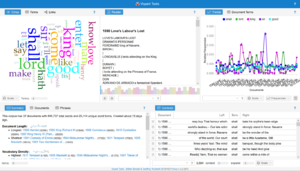Voyant Tools
Topic: Software
 From HandWiki - Reading time: 3 min
From HandWiki - Reading time: 3 min
 | |
| Developer(s) | Stéfan Sinclair & Geoffrey Rockwell |
|---|---|
| Initial release | 2003 |
| Stable release | 2.2
|
| Repository | https://github.com/voyanttools/Voyant |
| Operating system | Cross-platform |
| Available in | 10 languages |
| Type | Text analysis, statistical analysis, data mining |
| Licence | Web Application: Creative Commons Attribution 4.0 International Code: GPL3 |
| Website | http://voyant-tools.org |
Voyant Tools is an open-source, web-based application for performing text analysis. It supports scholarly reading and interpretation of texts or corpus, particularly by scholars in the digital humanities, but also by students and the general public. It can be used to analyze online texts or ones uploaded by users.[1] Voyant has a large, international user base: in October 2016 alone, Voyant's main server had 81,686 page views originating from 156 countries, invoking the tool 1,173,252 times.[2]
Voyant "was conceived to enhance reading through lightweight text analytics such as word frequency lists, frequency distribution plots, and KWIC displays."[3] Its interface is composed of panels which perform these varied analytical tasks. These panels can also be embedded in external web texts (e.g. a web article could include a Voyant panel that creates a word cloud from it). The book Hermeneutica: Computer-Assisted Interpretation in the Humanities demonstrates different approaches to text analysis using Voyant.[4]
History
Voyant Tools was developed by Stéfan Sinclair (McGill) and Geoffrey Rockwell (University of Alberta) and continues to be updated. It developed out of earlier text analysis tools including HyperPo, Taporware, and TACT. Contributors have included Andrew MacDonald, Cyril Briquet, Lisa Goddard, and Mark Turcato.[1]
Range of Uses
Researchers have used Voyant Tools to analyze texts in a wide range of contexts including literature,[5] language teaching,[6] healthcare,[7][8] and system architecture.[9] Describing approaches to studying the internet using web scraping, Black has noted that "the Voyant Tools project is an excellent source to learn about the kinds of data that humanists can extract from Internet sources because it already supports text extraction from webpages."[10]
A number of international digital humanities projects are running Voyant on their own servers. These include the French Huma-Num project, the Italian CNR ILC, and the German DARIAH-DE project.[2]
External links
- Voyant Tools
- Voyant Tools repository on GitHub
References
- ↑ 1.0 1.1 "Voyant Tools Help". http://voyant-tools.org/docs/#!/guide/about.
- ↑ 2.0 2.1 Sinclair, Stéfan; Rockwell, Geoffrey (2016). "Voyant Facts". Stéfan Sinclair & Geoffrey Rockwell. http://hermeneuti.ca/VoyantFacts.
- ↑ Klein, Lauren F.; Eisenstein, Jacob; Sun, Iris (2015). "Exploratory Thematic Analysis for Digitized Archival Collections". Digital Scholarship in the Humanities 30 (Supp. 1): i138. doi:10.1093/llc/fqv052.
- ↑ Rockwell, Geoffrey; Sinclair, Stéfan (2016). Hermeneutica: Computer-Assisted Interpretation in the Humanities.. Cambridge: MIT Press. ISBN 9780262332057.
- ↑ Rambsy, Kenton (2016). "Text-Mining Short Fiction by Zora Neale Hurston and Richard Wright using Voyant Tools". CLA Journal 59 (3): 251–258.
- ↑ McIlroy, Tara (2013). "Exploring Poetry and Identity in a Language Learning Environment". Studies in Linguistics and Language Teaching 24: 31–45.
- ↑ De Caro, W.; Mitello, L.; Marucci, A.R.; Lancia, L.; Sansoni, J. (2016). "Textual Analysis and Data Mining: An Interpreting Research on Nursing". Studies in Health Technology and Informatics 225: 948. PMID 27332424.
- ↑ Maramba, Inocencio Daniel (2015). "Web-based textual analysis of free-text patient experience comments from a survey in primary care". JMIR Medical Informatics 3 (2): e20. doi:10.2196/medinform.3783. PMID 25947632.
- ↑ Moullec, Marie-Lise; Jankovic, Marija; Eckert, Claudia (2016). "Selecting system architecture: What a single industrial experiment can tell us about the traps to avoid when choosing selection criteria". System Architecture Design 30 (3): 250–262.
- ↑ Black, Michael L. (2016). "The World Wide Web as Complex Data Set: Expanding the Digital Humanities into the Twentieth Century and Beyond through Internet Research". International Journal of Humanities and Arts Computing 10 (1): 106. doi:10.3366/ijhac.2016.0162.
 |
 KSF
KSF